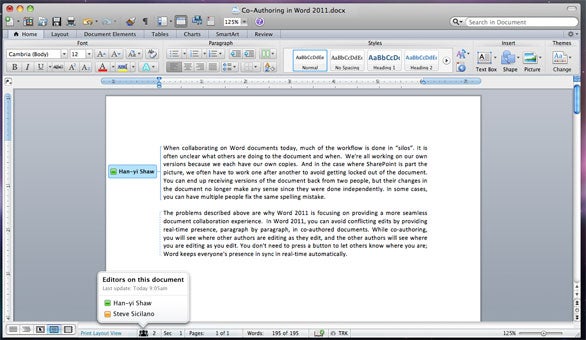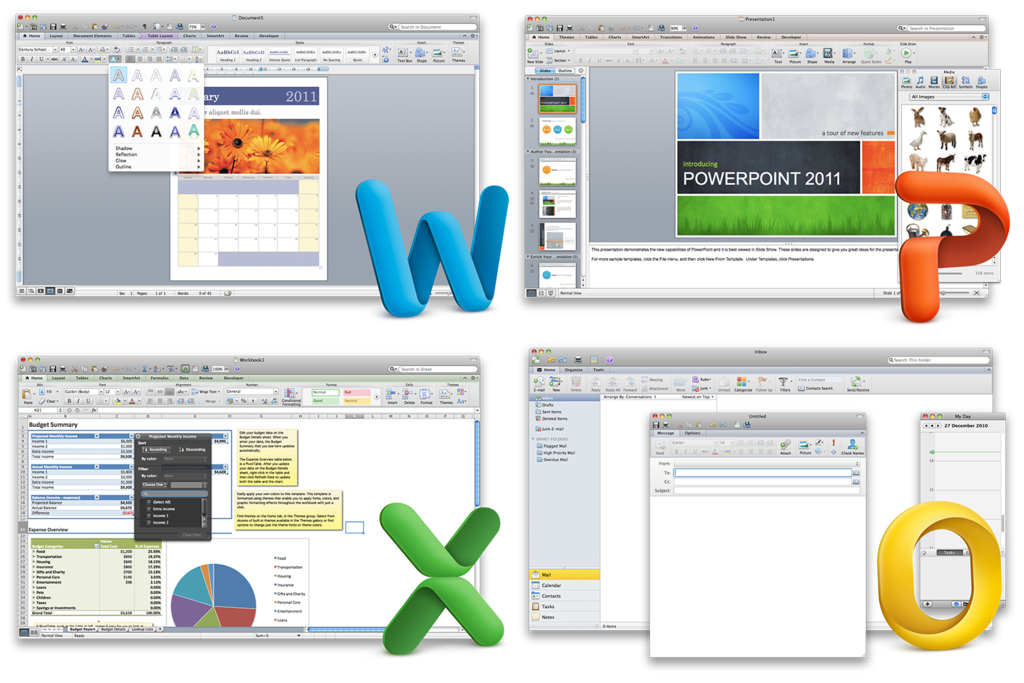Microsoft launched MS Office 2011 for Apple mac.
Microsoft Office for Mac 2011 is the most recent version of the Microsoft Office productivity suite for Mac OS X. It is the successor toMicrosoft Office 2008 for Mac and is comparable to Microsoft Office 2010 for Windows.Microsoft Office 2011 includes more robust enterprise support and greater feature parity with the Windows edition. Its interface is now more similar to Office 2007 and 2010 for Windows, with the addition of the Ribbon. A new version of Outlook, written using Mac OS X's Cocoa API, returns to the Mac for the first time since 2001 and has full support for Exchange 2007.[citation needed] It replaces Entourage, which was included in Office 2004 and 2008 for Mac.Support for Visual Basic for Applications macros returned after having been dropped in Office 2008.
In addition, Office 2011 supports online collaboration tools such as Windows Live SkyDrive and Office Web Apps, allowing Mac and Windows users to simultaneously edit documents over the web. Office for Mac 2011 has a number of limitations compared to Office 2010 for Windows. It does not support ActiveX controls,OpenDocument Format, or right-to-left languages such as Arabic, Persian and Hebrew. It also cannot handle attachments in Rich Text Format e-mail messages sent from Outlook for Windows, which are delivered as winmail.dat attachments.
Two editions are available to the general public. Home & Student provides Word, Excel and PowerPoint, while Home & Business adds Outlook and increased support. Microsoft Messenger 8 is included with both editions, and Microsoft Communicator for Mac 2011, which communicates with Microsoft Lync Server, is available only to volume licensing customers.Office 2011 requires an Intel Mac running Mac OS X 10.5.8 or higher.
Compatibility, collaboration
To the Mac Business Unit, compatibility means more than making sure that documents, spreadsheets, and presentations created on one platform open and render correctly on the other. Noting that roughly three quarters of their Mac users use Windows at least occasionally, Microsoft’s Mac team says it's also working to make the new Office for the Mac more functionally compatible with the Windows edition.
“Nowadays, compatibility means more than just file formats,” Microsoft’s Kurt Schmucker told TechnoPIRATE. “It’s also workflow, collaboration, and user interface.”
To that end, the new version of Office will incorporate document-collaboration features that take advantage of Microsoft's online storage features. With Office for Mac 2011, Mac users will be able to share files and collaborate on documents with other Mac and Windows users via Microsoft's SharePoint, SkyDrive, and Office Web Apps.
Those online tools will allow users to collaborate on documents with other Windows and Mac Office users in real time, much as you can in Google Docs now. You could, for example, create a document in Word on your laptop, save it to SkyDrive, then share it with others. A pop-up in Word will show you who’s working on the document; click on that list, and you’ll be able to send them a message (as long as everyone is using Outlook or Microsoft’s Messenger IM application). The paragraphs your collaborators are working on will be locked out until they’re done. You’ll also be able to edit those same documents from any computer, using Office’s Web apps. Mac users will have the same experience in the their versions of Safari and Firefox as Windows users get with their browsers, Schmucker said.
Lessons learned

Microsoft also says it’s learned from user feedback about Office 2008 and has tweaked the user interface accordingly in Office 2011.
Most notably, there’s a new Ribbon at the top of each document window. (If you want a preview, check out Office for Windows; the ribbon is already in there, although the Microsoft Mac team members we spoke to said they had learned a lot from the criticism the Ribbon took when launched on Windows.) The Mac version of the Ribbon doesn’t replace any menu bars, but it does replace Office 2008’s controversial Elements Gallery, which took some fire from Mac users for its size and inflexibility. This new Ribbon is designed to give users quick access to each program's most commonly used tools. Unlike the Elements Gallery, the ribbon is customizable and, if you want more screen space, completely collapsible.
The new suite will also feel more Mac-like than Office 2008. For example, the Ribbon is built entirely using Apple’s Cocoa development framework, and takes takes advantage of Apple’s Core Animation system. (As a result, Ribbon tabs will slide smoothly when you rearrange them.) If you click on some Ribbon tools, they will expand smoothly into popovers that don’t obscure the document you’re working on. We even spied a non-modal search box on the right side of the toolbar, right where you’d expect it to be, allowing you to quickly search through documents without having your content blocked by a floating box.

A closer look at the new Ribbon in Office for Mac 2011.
Summarizing the interface changes, Microsoft's Han-Yi Shaw likened Office 2008 to a teenager—“a little quirky”—but said the new edition is Office matured. “This is the version that everyone wanted,” he said.
Shaw added that the Mac team at Microsoft worked hard to adopt Apple technologies while also making sure their product was recognizably Microsoft Office. “We’re at a cross-section of Mac and PC, and because we’re die-hard Mac users, we look at the [Office] technology and try to translate it,” he said. “Following the Apple design philosophy really takes you in the right direction.”
Outlook and Visual Basic
The other big news in Office 2011 is the demise of Entourage and the return of Outlook.
The new Outlook will support PST imports (allowing you to move an Outlook installation, including all your old e-mails, from a Windows PC to a Mac). It will also support Microsoft’s Information Rights Management (IRM), which allows senders to specify what recipients can do with messages (print, forward, and so on). Previously-Windows only, IRM is required in some corporate settings. IRM support in Office 2011 is aimed at Mac users in cross-platform environments, Schmucker said: “It’s been a blocker for some companies because the Mac support was not there.”
And Microsoft has re-engineered the Outlook message database system to be a series of small files, so it’s more easily backed up with Time Machine and searched in Spotlight. “Outlook’s new database is more reliable, faster, and fully supports Time Machine and Spotlight,” Schmucker said.
Finally, power users will be glad to see the return of the Visual Basic macro language. Visual Basic was dropped from Office 2008 in part because it was too technically difficult to port it to the Mac’s then-new Intel CPUs. Microsoft says it began work on that port as far back as 2008—before the last Mac Office shipped. That work is now complete. And the Mac suite will be using the most up-to-date version of Visual Basic, so it’ll be much more compatible with Office for Windows than the Visual Basic in previous versions of Office for Mac.

